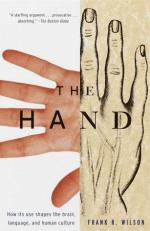|
This section contains 422 words (approx. 2 pages at 400 words per page) |

|
The Hand: How Its Use Shapes the Brain, Language, and Human Culture Summary & Study Guide Description
The Hand: How Its Use Shapes the Brain, Language, and Human Culture Summary & Study Guide includes comprehensive information and analysis to help you understand the book. This study guide contains the following sections:
This detailed literature summary also contains Topics for Discussion and a Free Quiz on The Hand: How Its Use Shapes the Brain, Language, and Human Culture by Frank R. Wilson.
This non-fiction analytical description of "The Hand" subtitled "How its use shapes the brain, language, and human culture" was published in 1998 by Frank R. Wilson. Wilson presents a cultural and historical tale of the use and development of the human hand that supports human learning, physical characteristics and development before and since Homo sapiens appeared on earth. Earliest appearance of a man-like creature was the Australopithecine, which is the name of the first "southern apes" that walked upright in Africa. "Lucy" is a fossilized example who appeared on earth 3.9 million years ago.
Wilson's patients suffering symptoms of "musician's cramp" made him aware of difficulties sculptors, carvers and surgeons experience. His mission for this book is to expose the "hidden physical roots" of human capacity for passionate, creative work. He discusses the anthropological, evolutionary, biomechanical and physiological features as well as neurobehavioral and developmental perspectives. The author's underlying thesis is that people are innately resourceful, curious and willing to explore and learn over time and through experience to become skillful and thoughtful. Wilson claims the unique structure of the hand and its evolution in partnership with a brain makes modern man, Homo sapiens, the most intelligent animal on earth.
The author's voluminous research is supported by an appendix, endnotes, a bibliography and an index and is written objectively but offset ironically with subjective stories of his friends' experiences. For example, his friend Jack's hot-rod cars demonstrate the scientist Reynold's heterotechnic cooperation process. Other examples are Chef Reed's kitchen warrior skills and jeweler George's success at adapting to severed fingers. The wide breadth of Wilson's experience, knowledge and presentation may seem rambling for some casual readers.
Wilson's non-fiction study of "The Hand" is a casual, somewhat humorous, light-hearted read packed with academic research. For example, Chapter 14, "Hidden in the Hand" is an ironic euphemism for this chapter that compares the skillful fiberoptic tool cutting of a wrist by a microsurgeon to the sleight of hand used by magicians. Content of each chapter roams far and wide, like the Greenfield study titled in part "The Ontogeny and Phylogeny of Hierarchically Organized Sequential Behavior" that introduces the chapter on his friend Jack's hot-rod racing cars. The author's style of offsetting extensive academic references, such as 50 pages of endnotes, with simple stories about chefs, hot-rods and a jeweler that cut off his fingers keeps a casual reader wondering what may appear on the next page. An unknown tale of the hand and cultural humanity of man comes to life in Wilson's "The Hand."
Read more from the Study Guide
|
This section contains 422 words (approx. 2 pages at 400 words per page) |

|



